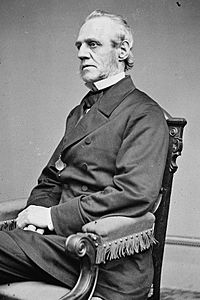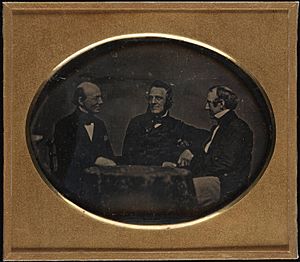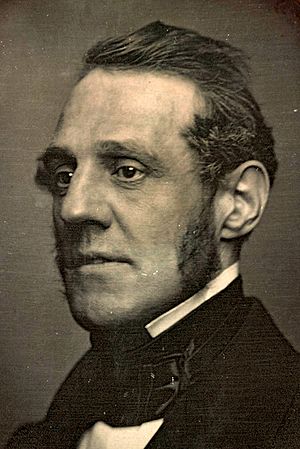George Thompson (abolitionist) facts for kids
Quick facts for kids
George Thompson
|
|
|---|---|
 |
|
| Member of Parliament for Tower Hamlets |
|
| In office 1847–1852 |
|
| Preceded by | Charles Richard Fox |
| Succeeded by | Charles Salisbury Butler |
| Personal details | |
| Born | 18 June 1804 Liverpool, England |
| Died | 7 October 1878 (aged 74) Leeds, England |
| Political party | Radical |
| Spouse |
Anne Spry
(m. 1831; died 1878) |
| Children | 6 |
| Occupation | Abolitionist, activist, politician |
George Donisthorpe Thompson (born June 18, 1804 – died October 7, 1878) was a very important British speaker and activist. He worked hard to end slavery and protect human rights. George Thompson gave many lectures and helped create laws against slavery. He was a Member of Parliament (MP) in the United Kingdom. Many people consider him one of the most important abolitionists in both the United Kingdom and the United States.
Contents
Early Life and Activism
George Thompson did not go to school for very long. He mostly taught himself by reading and learning on his own. When he was 18, he started a group to help people improve themselves. He also joined debate clubs. This showed his early interest in learning and discussing important issues.
His father worked on a ship that traded enslaved people. His father's stories about the terrible things he saw made a big impact on young George. These stories about the cruel treatment of enslaved people stayed with Thompson. They helped him decide to fight against slavery.
Fighting Slavery in Britain
At first, George Thompson did not know much about slavery. But he was a very good speaker. A group hired him to argue that slavery should be ended right away. This idea was called "immediatism." It meant slavery was wrong in God's eyes and needed to stop immediately.
Thompson quickly started sharing this message. He said, "To uphold slavery is a crime before God, and the condition must, therefore, be immediately abolished." In 1832, he traveled to Scotland. There, he became interested in ending slavery in the United States and other parts of the world. In Scotland, he met William Lloyd Garrison, who became a lifelong friend. He also met Nathaniel Paul, an African-American abolitionist. In Glasgow in 1833, he debated Peter Borthwick, who was paid to defend slavery.
Thompson was invited by Garrison to visit New England in the United States. His supporters in Glasgow and the Edinburgh Emancipation Society helped him with this trip. From 1836 to 1847, Thompson was active in all the major anti-slavery talks in Britain. This included the 1840 World Anti-Slavery Convention in London. In 1847, he was elected to the House of Commons. He became a Member of Parliament (MP) for Tower Hamlets.
Thompson also supported other causes. He wanted reforms in British India and believed in free trade. He was also part of the Chartism movement, which pushed for more rights for working people. He supported nonresistance and the peace movement. However, his most important work was ending slavery. He often spoke out against laws that only limited slavery a little bit. He wanted all enslaved people to be freed quickly. He was not happy with the British Emancipation Act of 1833. This law made enslaved people work as apprentices for six years after they were "freed." So, he used his position in Parliament to push for better laws.
Working Against Slavery in America
George Thompson was a very active speaker. He often pointed out how America helped keep slavery going. He first traveled to the United States in 1834. There, he caught the attention of people who supported slavery. He barely escaped being caught by them after one of his lectures.
His lectures that year helped start over 150 anti-slavery groups across the US. He inspired many people to join the fight against slavery. But the resistance to his ideas did not stop. He was forced to return to Britain. He traveled through Tasmania (Australia) on his way home. A newspaper in Tasmania reported that Thompson had arrived in New Brunswick, Canada. He wrote that he had left the United States to "escape the assassin's knife." The newspaper added that people had tried to "burn and murder" him in several US towns.
When the Fugitive Slave Law was passed in 1850, Thompson returned to the United States. This time, he was very popular among those who wanted to end slavery. The movement had grown much larger and more powerful.
In 1859, with his son-in-law Frederick William Chesson, he started the London Emancipation Society. This group strongly supported the Union side during the American Civil War. In 1860, Thompson and Frederick Douglass debated whether the United States Constitution supported or opposed slavery. Their debates were very public and later printed as a pamphlet.
During his last visit in 1864, he worked with William Wells Brown to push for the end of slavery. He also met Abraham Lincoln. Thompson supported and saw the final defeat of the Confederacy at Fort Sumter in 1865.
British India Society
George Thompson helped create the British India Society in 1839. He was also the President of the Bengal British India Society, which started in 1843. These groups wanted to understand the real lives of people in British India. They also aimed to encourage loyalty to British rule and promote the public's general interests.
Return to England and Death
Thompson became ill and went back to England. He died in 1878 and was buried in Beckett Street Cemetery, Leeds. After his death, his work against slavery was not widely remembered. However, his efforts to create a worldwide movement to end slavery were very important. He made a living as an activist, supporting the cause he cared about deeply. This allowed him to make big steps in freeing enslaved people around the world.
Personal Life
On January 29, 1831, George Thompson married Anne Erskine Lorraine Spry in Islington. Thompson had several children who grew up to be adults. These included Louisa Eliza Spry, Amelia Ann Everard, George Herbert, and Edith. Another son, named after William Lloyd Garrison, died when he was 15. A daughter, named after Elizabeth Pease, died at age 6.
Images for kids




